Gitzo GS3512S Center Column Review
Read any serious photography article about technique and there’s one thing that will repeated; use a tripod, preferably one without a center column, but if it has one, don’t extend it.
It’s good advice. No, strike that, it’s safe advice. It’s advice anyone can follow that won’t lead them wrong. However, it’s the kind of unnuanced advice that makes me cringe even though I know it’s better to tell someone to keep that center column down than try and explain when it’s safe to use it.
I followed that thinking for quite a long time. Doing so never hurt my images, but I almost never used the center column on my old Bogen 055 tripod, and when I bought my carbon fiber Gitzo GT3530LS, I didn’t even bother with the center column.
That changed when the bulk of my shooting moved from the landscapes and wildlife to products in the studio. In the studio, even though my shutter is open for 1/200th or 1/250th of a second, the actual exposure is closer to 1/2,000th or even faster due to the flash pulse. With exposures that short, there’s virtually no time for camera shake, let alone mirror slap to affect the image.
However, while the strobes eliminate mirror slap, let alone camera shake; it’s still often necessary to position the camera in a fixed location for focusing and repeatability. Moreover, it’s also necessary to make vertical adjustments, often, fine ones, to achieve desired compositions. Vertical adjustments using only the tripod legs is no nice task, and even then often lacks the finesse to make exactly the adjustment desired. This brings us back to the center column, specifically the GS3512S for Gitzo’s Series 3 systematic tripods.
Gitzo makes a number of center column options for their 3-series tripods, both geared and rapid column designs in both carbon fiber and aluminum, with travels ranging from just over 14-1/2 inches to just over 12-inches. I was looking for a rapid column in carbon fiber, which narrowed my choices down to just the GS3512S.
The GS3512S is the upgraded version of the GS3511S, and is designed for the current line of Gitzo tripods that include a top plate safety mechanism that insures the top plate can’t work free from the center casting. Fortunately, the new design is compatible with older Gitzo tripods like the GT3530LS.
Vertical adjustment is controlled by a single large double-ended lever just above the mounting plate. The rapid column design is entirely friction controlled, and there is no lubrication. I’ve found the compression lock mechanism (somewhat similar to the way Gitzo’s leg locks work) provides a solid feel when tightened down. Moreover, it doesn’t take an awful lot to go from lose enough to adjust to fully tight, only about a quarter of a turn is necessary to get things sliding.
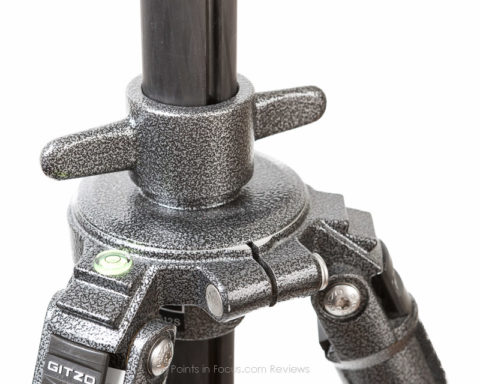
Since this is a rapid column design, how much load is currently on the tripod plays some role in how easy it is to adjust. I’ve also had the column bind slightly on downward adjustment. I’m not sure if this was a product of over loosening the lock and allowing too much play on the column or what. It doesn’t occur frequently and seems to become less of an issue as time goes on.
The top platform has a reversible 3/8-16 and 1/4-20 threaded stud. I can’t say I entirely grasp the need for the 1/4-20 stud since most tripod heads use 3/8-16 sockets. The top plate, and the stud, can be locked down by tightening the 3mm hex-head setscrew accessible from the top of the top plate.
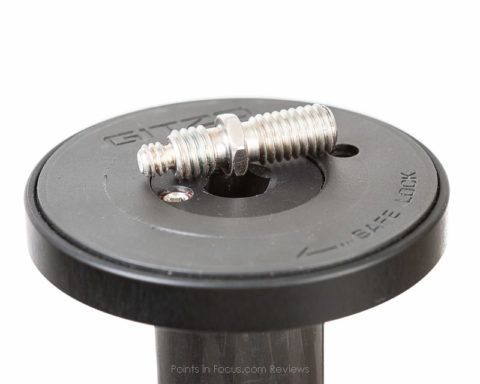
Additionally an attached tripod head can be locked by tightening the 3mm hex-head setscrew on the underside of the top plate. Of a side note, the lower screw is just at the edge of where a Really Right Stuff MTX tool will fit.
Like most center columns, the GS3512S interferes with the low-level operation of the tripod. In the down position, the legs can only be spread to the middle position, putting the base of the tripod head just under 19-inches off the ground.
However, like most center columns, the GS3512S is reversible so you can sling it from below the tripod allowing the camera to be low enough that it touches the ground.
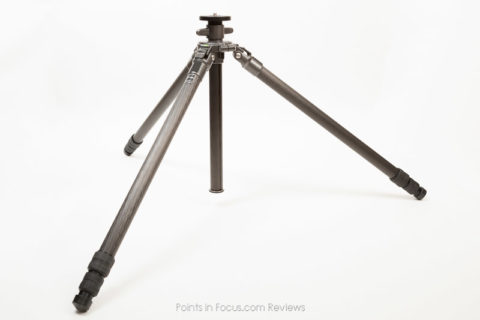
The reversal process starts by unscrewing the hook from the bottom end of the center column. The joint between the hook unit and the center column is sealed by an O-ring, so it turns harder than you would expect. Note you have to turn the whole bottom part, not just the hook itself.
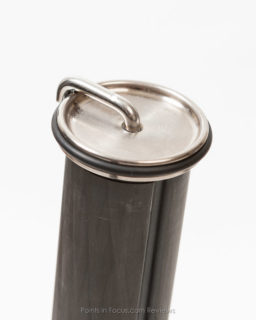
With the hook removed, loosen the lock knob and slide the center column out, then reverse the column and slide it in from the bottom. Also note, to keep the center column from rotating, there’s a slot in it that lines up with a ridge in the base, it needs to be aligned when you go to reinsert the reversed column.
Finally, reattach the hook unit. Though not strictly necessary I like it to be there, as it will keep the column from falling out with the camera attached if the lock is loosened for some reason.
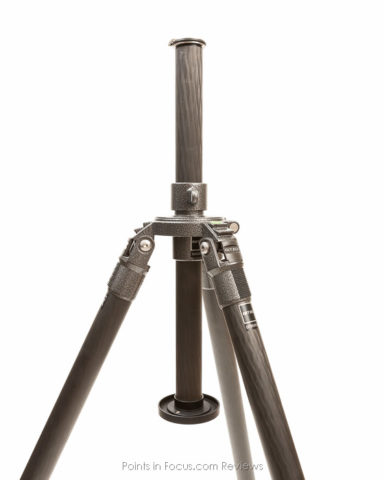
With all the talk about center columns reducing stability it seems reasonable to at least briefly look at how extending this center column affects the image. These tests were done with a Canon EOS-1D Mark III and an EF 100-400mm f/4.5-5.6L IS USM lens at 300mm. Two 1-second exposures were made at the fully extended and fully retracted positions, one with mirror lockup enabled, and 1 without out. The 1-second exposure to maximize the impact of mirror slap vibration.
| Column Fully Lowered | Column Fully Extended | |
| Mirror Lockup Disabled | 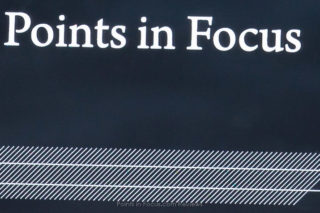 |
|
| Mirror Lockup Enabled | 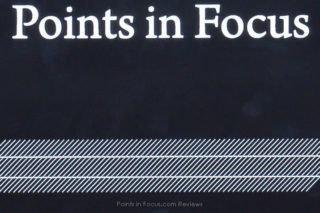 |
The results from the extended column with mirror lockup are very good, pretty much on par with both retracted column images. On the other hand, the extended column no-MLU image definitely shows vibration issues.
In the end, it seems the GS3512S is at least rigid enough to support challenging exposures while fully extended, so long as care is taken to minimize mirror slap.
With all that said, is a center column, and more specifically the GS3512S right for you?
That depends; if you’re a studio shooter who needs absolute control over camera height, you’re probably better off with one of the geared alternatives. The rapid column can be just too fiddly to get just perfect. On the other hand, the GS3512S is light and quick to adjust and that makes it ideal for both the non-perfectionist studio user as well as someone looking for a more adjustable macro rig than just setting their tripod to the ultra-low position.
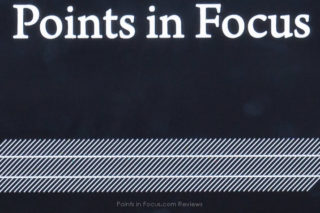
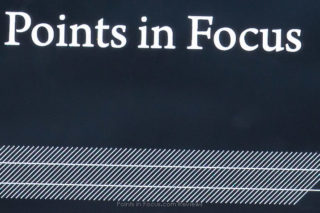
Comments
There are no comments on this article yet. Why don't you start the discussion?